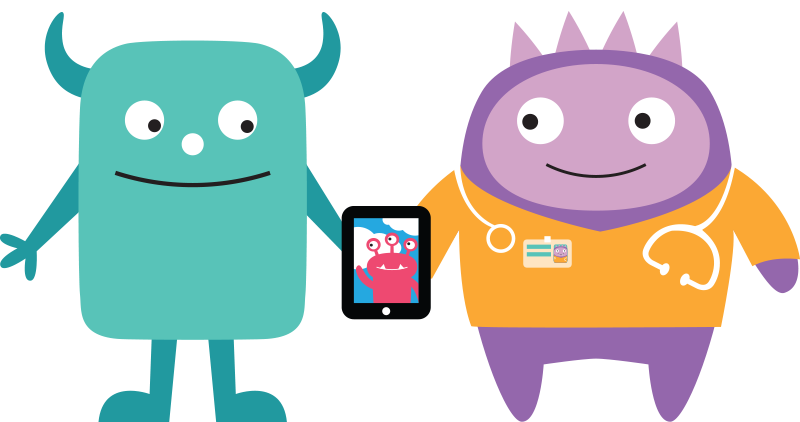We are living in a time where the technology we have at our fingertips influences every aspect of our daily lives. From the moment we wake up we are inundated with news, social media feeds, programs that give us directions, traffic updates, recipes – anything we wonder, we can have an answer to within seconds. Times they are a changin’ folks.

Intervention and Assesment

While technology and medicine have been married for ages, we have only just begun to see how advances in technology can impact a patient’s personal medical experience; albeit a procedure, surgery, new diagnosis, long-term illness, hospitalization, etc. While some of us adults are just trying to keep up, our kids are growing and developing alongside these technological discoveries at home, in school and in healthcare settings. Pediatric healthcare providers, patients and their families are taking advantage of available resources such as apps and web-based tools that can improve their ability to understand and cope with their medical experience.
Let’s be honest. There are a plethora of medical apps available for kids for everything from education to coping and distraction (we’ll post a blog on that later), but we hadn’t come across a tool that could provide personalized interventions based on a patient’s unique needs…until now. “Distraction in Action” is an interactive web-based assessment and intervention tool designed to reduce stress, anxiety and pain in pediatric patients during procedures.
We caught up with one of the researchers and developers of “Distraction in Action” to learn more. Kirsten Hanrahan is a Nurse Scientist at the University of Iowa Hospitals and Clinics. She is part of a research team studying interventions for painful medical procedures in children. Here’s how it went
How was the idea for Distraction in Action was conceived?
The idea for Distraction in Action really came from a clinical problem. In the early 1990’s, a nurse came out of one of our pediatric treatment rooms, grabbed the first person she saw and said, “Something has got to be done for these kids having painful procedures!” That person was Dr. Ann Marie McCarthy. She began collaborating with Dr. Charmaine Kleiber and I on a series of studies on this topic. Our early vision was to develop a tool that would help nurses and parents identify which children could cope during procedures and which children needed more intensive interventions by professional. The Distraction in Action Tool (DAT) came from our research about that clinical problem and our vision to help.
Who is on the development team?
The primary team of developers is Ann Marie McCarthy, PhD, RN, FAAN; Charmaine Kleiber, PhD, RN, FAAN, and Kirsten Hanrahan, DNP, ARNP, CPNP. We all have a background in Pediatric Nursing. Ann Marie has a degree IN Psychology as well. Our work has been a collaboration between the UI College of Nursing and UI Hospitals. More recently, Ben Miller joined the development team. Ben is a Child Life Specialist and is currently working on his PhD in Education. Beyond the primary group, we have had an evolving team over the years, including professional colleagues from Business, Medicine, Nursing, Phlebotomy, Child Life Services, Information Technology (IT) and more.
Did you experience any challenges during the process of developing the Distraction in Action Tool?
In one of the first studies we did, parents chose from a menu of interventions (e.g. hypnosis, imagery, distraction, therapeutic play) to help their child during a painful procedure. What happened was that distraction was so helpful that the clinicians started using it with their other patients. Our control group was contaminated, but from it we learned that distraction was an easy to use, effective intervention. There were many challenges like this over the years, but we learned from each one and in the end it made the work stronger. Our research spans over 25 years. In the last 10 years we tested two prototypes for DAT. We are ready to launch our Distraction in Action website and DAT for parents to use.
Why is procedural distraction important?
Untreated procedural pain has both short and long-term negative consequences. Children may respond to painful procedures with physiological symptoms (e.g. increased heart rate, elevated hormone response) that stress the child, and behavioral responses that make the procedure more difficult (e.g. flailing, screaming). Over time, this can result in increased pain sensitivity and avoiding medical care. Distraction is an evidence-based method for reducing pain and distress with medical procedures. We think distraction is an important intervention because it can be implemented anywhere, it can be used alone or with other interventions (such as medications), and parents or healthcare providers can be trained to do it when professionals (e.g., Child Life Specialist) with expertise in the use of distraction, are not available.
Tell us all about the tool and how it works.
DAT is a web-based decision support that can be accessed on the internet. The initial target audience is parents of young and school-aged children. Our research was done with children 4 to 10 years of age, but distraction also works for younger and older children. DAT is hosted by our Distraction in Action website. Users can access generic resources on the site, or create a login for an individualized profile and instructions using DAT. The parent and child answer a few questions and watch a brief training video about distraction. Then, based on data from over 1,000 children in our previous research, our model creates a prediction of the child’s risk for distress (DistrEstimate) and offers individualized instructions for the parent and child.
DAT does not replace the services of child life. We absolutely recognize that Child Life Specialists are experts at providing distraction and other interventions for medical procedures. In fact, our research demonstrates Child Life Specialists provide the highest quality of assessment and intervention. The DistrEstimate may help to identify where Child Life services are most needed or where the parent may be able to help. We also know that not all settings have a Child Life Specialist or they aren’t always available. In the absence of Child Life, parents with training provide higher quality distraction than parents without training. Our teaching video and instructions provide some basic preparation for parents and children. DAT can also be used by Child Life Specialist to work with parents wanting to participate more in their child’s care.
I also want to emphasize, Child Life Specialists were involved in DAT throughout our program of research and development of DAT. They provided distraction in some of our studies, helped us define and quantify quality distraction, and advised our scripts and instructions. Several Child Life Specialists, like Ben, have been research assistants and part of the development team. During the time of our research, the UI Child Life program has grown exponentially and now provides more distraction (and many other therapies) throughout the hospital.
In trialing the tool with patients and families, what have you concluded about the apps efficacy? Can you think of any specific “success stories” you can share?
We have learned that parents and healthcare providers found DAT helpful and easy to use. It does take some planning, and it takes 10-20 minutes to use it fully, but parents and healthcare providers were able to adapt their workflow to accommodate the time needed and thought it was worth the effort. There are many success stories, one I remember is a mother shared that after a visit to the clinic that required several procedures, her daughter went home and told everyone about her day “playing easy-bake oven.” The mom reported her daughter enjoyed playing DAT games on the tablet and that was what she remembered from the visit.
What are your hopes for the future of the Distraction in Action tool?
We want to make DAT (and other resources like our teaching videos) available for parents and healthcare professionals to use in any setting. Our hope is that distraction and other effective interventions would be used routinely for painful procedures in children, resulting in reduced pain and distress. We hope that Child Life Specialists will use DAT in new ways and let us know what works and doesn’t work. We also have a DAT for healthcare professionals in development.
Tell me how you see the role of technology impacting the future of pediatric healthcare.
We see digital media as a way for trained healthcare professionals to extend their reach to other areas. Parents want to help their children cope with painful medical procedures. They look to digital media for support. We think it is important to offer them research-based resources and DAT is based evidence from our extensive program of research.

